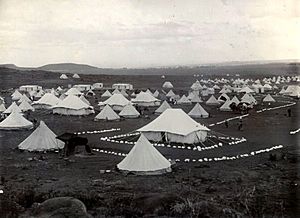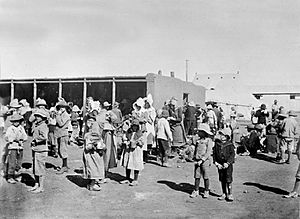Second Boer War concentration camps facts for kids


During the Second Anglo-Boer War which lasted from 1899–1902, the British operated concentration camps in the South Africa Republic, Orange Free State, Transvaal and the Cape Colony, part of what is now South Africa.
In the year 1900, Herbert Kitchener took command of the British forces and initiated plans to deter guerrillas in a series of systematic drives, sweeping the country bare of everything that could give sustenance to the guerrillas.
Large epidemics of diseases including measles, killed thousands, affecting children the most.
As Boer farms were destroyed by the British under their "Scorched Earth" policy—including the systematic destruction of crops and the slaughtering or removal of livestock, the burning down of homesteads and farms—to prevent the Boers from resupplying themselves from a home base, many tens of thousands of men, women and children were forcibly moved into the camps. This was not the first appearance of internment camps, as the Spanish had used internment in Cuba in the Ten Years' War, but the Boer War concentration camp system was the first time that a whole nation had been systematically targeted, and the first in which some whole regions had been depopulated.
Eventually, there were a total of 45 tented camps which were built for Boer internees and 64 additional camps which were built for black Africans. Of the 28,000 Boer men who were captured as prisoners of war, 25,630 were sent overseas. The vast majority of Boers who remained in the local camps were women and children. Between 18,000 26,000 women and children perished in these concentration camps due to diseases.
The camps were poorly administered from the outset and they became increasingly overcrowded when Lord Kitchener's troops implemented the internment strategy on a vast scale. Conditions were terrible for the health of the internees, mainly due to neglect, poor hygiene and bad sanitation. The supply of all items was unreliable, partly because of the constant disruption of communication lines by the Boers. The food rations were meagre and there was a two-tier allocation policy, whereby families of men who were still fighting were routinely given smaller rations than others. The inadequate shelter, poor diet, bad hygiene and overcrowding led to malnutrition and endemic contagious diseases such as measles, typhoid and dysentery to which the children were particularly vulnerable. Coupled with a shortage of modern medical facilities, many of the internees died.
Images for kids
-
Emily Hobhouse campaigned for improvement to the appalling conditions of the concentration camps. She helped to alter public opinion and to force the government to improve conditions in the camps, resulting in the Fawcett Commission.
-
The 1st Baron Kitchener of Khartoum, as he then was styled, was one of the most controversial British generals in the war. Lord Kitchener took over control of British forces from Field Marshal The 1st Baron Roberts and was responsible for expanding the British response to the Boers' guerrilla tactics.




